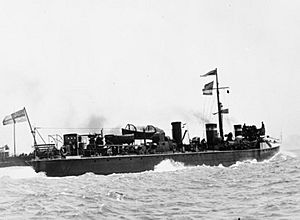HMS Dasher (1894) facts for kids
 |
|
Quick facts for kids History |
|
|---|---|
| Name | HMS Dasher |
| Builder | Yarrow Shipbuilders, Poplar, London |
| Laid down | December 1893 |
| Launched | 28 November 1894 |
| Completed | March 1896 |
| Fate | Sold for Scrapping, 14 May 1912 |
| General characteristics | |
| Class and type | Charger-class destroyer |
| Displacement | 255 long tons (259 t) |
| Length | 195 ft (59 m) |
| Beam | 18.5 ft (5.6 m) |
| Draught | 7.25 ft (2.2 m) |
| Propulsion |
|
| Speed | 27 knots (50 km/h; 31 mph) |
| Armament |
|
HMS Dasher was a fast warship called a destroyer. She was part of the Royal Navy and belonged to the Charger-class destroyer class. This ship was built by Yarrow Shipbuilders in 1895. She spent her time serving in the waters around Britain and was later sold in 1911.
Contents
Building a Destroyer: HMS Dasher's Design
Ordering New Warships
In 1893, the British Admiralty (which was like the main office for the British Navy) decided to order three new warships. These ships were called torpedo boat destroyers. They were designed to be very fast and carry torpedoes to attack larger enemy ships.
HMS Dasher was one of these three ships, along with Charger and Hasty. They were all built by a company called Yarrow Shipbuilders in Poplar, London.
What Destroyers Needed
The Navy didn't give the shipbuilders a super strict design plan. Instead, they gave them some general rules. These rules included:
- The ship needed to reach a speed of 27 knots (31 mph; 50 km/h) during tests.
- It had to have a special "turtleback" shape at the front, called a forecastle.
- The weapons on board would change depending on what the ship was doing.
If the ship was acting as a "torpedo boat," it would have:
- One main 12-pounder gun (about 3 in (76 mm) wide) on a platform. This platform was also used as the ship's bridge, where the captain steered.
- Three smaller 6-pounder guns.
- Two 18-inch (450 mm) torpedo tubes.
If it was acting as a "gunboat," one of the torpedo tubes could be removed to make space for two more 6-pounder guns.
Dasher's Size and Power
Yarrow's design for Dasher made her about 195 feet 0 inches (59.44 m) long from end to end. She was about 18 feet 6 inches (5.64 m) wide. When she was light, she weighed about 255 long tons (259 t).
To make her move, Dasher had two locomotive boilers. These boilers heated water to make steam, which powered two triple-expansion engines. These engines could produce about 3,000 indicated horsepower (2,200 kW) of power!
Building and Upgrading Dasher
Dasher started being built in December 1893. She was officially launched into the water on 28 November 1894. During her sea tests, she reached a speed of 26.21 knots (30.16 mph; 48.54 km/h). She was finally finished and ready for service in March 1896.
When she was first built, Dasher used older "locomotive boilers." But newer "water-tube boilers" were becoming more common. So, in 1899-1900, Dasher was updated with these new water-tube boilers. This change also meant she went from having two funnels to three.
HMS Dasher's Time in Service
Joining the Fleet
In March 1901, Dasher was officially ready for duty at Chatham Dockyard. She joined a group of ships called the Medway Instructional Flotilla. This group helped train sailors.
An Unlucky Collision
Early in the morning of 15 April 1901, the Chatham Flotilla was sailing from Portsmouth to Devonport. The weather was very rough. Another destroyer, Cynthia, had to stop. When she tried to get back into position in front of Dasher, she accidentally crashed into Dasher's left side.
This crash made a hole below the water line on Dasher and damaged her steering! Luckily, Dasher was able to make it to Swanage Bay. There, the crew worked hard to pump out the water. She was then able to slowly sail back to Portsmouth at 8 knots (about 9 miles per hour). After that, she went to Chatham for repairs. Cynthia was also badly damaged.
Later Years and Retirement
In July 1901, Dasher took part in the Navy's training exercises, called Naval Manoeuvres.
On 17 January 1902, Dasher was ready for duty again. She stayed with the Medway flotilla for a couple of months. Then, in March 1902, she moved to the Devonport instructional flotilla. She also took part in a big fleet review in August 1902. This was a special event held at Spithead to celebrate the coronation of King Edward VII.
On 1 February 1909, Dasher accidentally ran aground (hit the bottom) on some sandbanks called South Shoebury Sands. But she was able to get herself free and sail into Sheerness on her own power.
Finally, on 14 May 1912, Dasher was sold to a company called King and Sons. They broke her up for scrap metal, ending her service with the Royal Navy.

